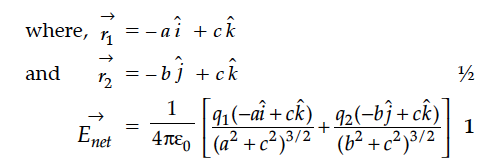Two point charges q1 and q2 are located at points (a, 0, 0) and (0, b, 0) respectively. Find the electric field due to both these charges at the point (0, 0, c).


A point charge +Q is placed in the vicinity of a conducting surface. Draw the electric field lines between the surface and the charge.
A charge q is placed at one corner of the cube. The electric flux passing through any one of its face is
Figure shows a point charge + Q, located at a distance R/2 from the centre of a spherical metal shell. Draw the electric field lines for the given system.
Two-point charges 2μC and 4μC are placed 2 cm apart. The ratio of the Coulomb’s force experienced by them is
(A) 1: 2
(B) 2: 1
(C) 1: 1
(D) 4: 1
Two charges q and –3q are placed on x-axis separated by distance d. Where a third charge 2q should be placed such that it will not experience any force ?
Two charges of 2uC and 5uC are placed 2.5 cm apart. The ratio of Coulomb's force experienced by them is
Electric flux emanating through a surface element placed in an electric field is
(A) 10 units
(B) 20 units
(C) 4 units
(D) 16 units
Write two properties of equipotential surfaces. Depict equipotential surfaces due to an isolated point charge. Why do the equipotential surfaces get closer as the distance between the equipotential surfaces and the source charge decreases ?
Two cells of E.M.F. 10 V and 2 V and internal resistances 10 Ω and 5 Ω respectively, are connected in parallel as shown. Find the effective voltage across R.
Two point charges q and –2q are kept d distance apart. Find the location of the point relative to charge q at which potential due to this system of charges is zero.
The figure shows a plot of terminal voltage ‘V’ versus the current ‘i’ of a given cell. Calculate from the graph
(i) emf of the cell and (ii) internal resistance of the cell.
Find the P.E. associated with a charge q if it were present at the point P with respect to the ‘setup’ of two charged spheres, arranged as shown. Here O is the mid-point of the line O1O2.
Five charges, q each are placed at the corners of a regular pentagon of side a.
(i) What will be the electric field at O if the charge from one of the corners (say A) is removed ?
(ii) What will be the electric field at O if the charge q at A is replaced by - q ?
Calculate the current drawn from the battery by the network of resistors shown in the figure.
